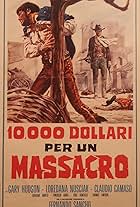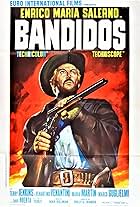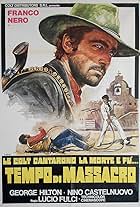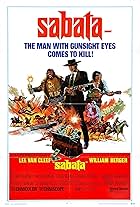A gang of outlaws find themselves in conflict with a mysterious, boomerang-wielding drifter and a widower who arrive in the ghost town they have holed up in.A gang of outlaws find themselves in conflict with a mysterious, boomerang-wielding drifter and a widower who arrive in the ghost town they have holed up in.A gang of outlaws find themselves in conflict with a mysterious, boomerang-wielding drifter and a widower who arrive in the ghost town they have holed up in.
Luis Dávila
- Phil
- (as Luis Davila)
Ana María Mendoza
- Bridget
- (as Anamaria Mendoza)
Antonio Orengo
- Priest at Hanging
- (uncredited)
Joaquín Parra
- Bearded Bandit
- (uncredited)
Diana Sorel
- Blonde Widow
- (uncredited)
- Director
- Writers
- All cast & crew
- Production, box office & more at IMDbPro
Storyline
Did you know
- TriviaA character known as Professor James Rorke appeared in a short, deleted scene wherein he offers Lou Castel's character a meal of biscuits and gravy at the hotel. It can be found on the rare American edition of the DVD.
- ConnectionsReferenced in Let the Corpses Tan (2017)
Featured review
Maybe Cesare Canevari fancied himself a radical, maybe he didn't care at all about doing a western in the first place, maybe he didn't really care a whole lot about making movies to begin with. Because Matalo is as much a western as something like Sukiyaki Western Django. People wear stetson hats and fire sixshooters at each other, they ride horses and there's a ghost town, but the rest is a blurred Gothic fantasy filmed in awkward closeups and frantic camera movements. It's artsy and aesthetically minded in the same way Jess Franco was artsy, that is to say the intention is there and sometimes the translation makes sense, but the cruddy execution is 70's European exploitation. The curtains are colored fiery red and the lightning of the overfurnished interiors is dark and expressive like it came from a horror movie or a spooky western by Antonio Margheriti.
The plot about a gang of psychopathic robbers seeking refuge in a dusty ghost town to count their dough while they wait for their boss to arrive so they can make the split, all this while the desert keeps spitting out parched half-dead stragglers at them, is bare bones. It doesn't make a lick of sense and I bet Canevari intented it that way; I can see someone trying to make a case about Matalo and existentialism, but I won't go there. The movie is more concerned with its own exaggerated theatrical shenanigans. It even has Lou Castel duke it out with the robbers using boomerangs. It has a halfmad bearded robber go wip the blue velvet bedsheets with a golden chain in slow motion, he then whips Lou Castel in slow motion out in the street, then a horse comes along and stomps him half to death, in regular motion this time (I'm kidding, it's slow motion again).
If you can imagine the inmates of an insane asylum turned loose on such a void script with a camera and filming equipment, someone has randomly worn the director's hat and points at various objects to be filmed, and a dozen of the other drooling imbeciles keep spinning the camera around, while others dressed in cowboy attire fire guns around them aimlessly and grimace into the camera; then you can imagine the way in which Matalo is special, even among spaghetti westerns. Now and then a half-competent band doles out fuzzy acid rock in the soundtrack. The use of slow motion is not rousing and lyrical like in Keoma, the baroque sensibilities are not as pronounced as those of Django Kill, the kitschen-sink craziness lacks El Topo's singularity of vision. It's mostly wired in a way to elicit "far out, man!" reactions from the psychotronic crowd; but they can always watch.. I dunno, Vampiros Lesbos?
The plot about a gang of psychopathic robbers seeking refuge in a dusty ghost town to count their dough while they wait for their boss to arrive so they can make the split, all this while the desert keeps spitting out parched half-dead stragglers at them, is bare bones. It doesn't make a lick of sense and I bet Canevari intented it that way; I can see someone trying to make a case about Matalo and existentialism, but I won't go there. The movie is more concerned with its own exaggerated theatrical shenanigans. It even has Lou Castel duke it out with the robbers using boomerangs. It has a halfmad bearded robber go wip the blue velvet bedsheets with a golden chain in slow motion, he then whips Lou Castel in slow motion out in the street, then a horse comes along and stomps him half to death, in regular motion this time (I'm kidding, it's slow motion again).
If you can imagine the inmates of an insane asylum turned loose on such a void script with a camera and filming equipment, someone has randomly worn the director's hat and points at various objects to be filmed, and a dozen of the other drooling imbeciles keep spinning the camera around, while others dressed in cowboy attire fire guns around them aimlessly and grimace into the camera; then you can imagine the way in which Matalo is special, even among spaghetti westerns. Now and then a half-competent band doles out fuzzy acid rock in the soundtrack. The use of slow motion is not rousing and lyrical like in Keoma, the baroque sensibilities are not as pronounced as those of Django Kill, the kitschen-sink craziness lacks El Topo's singularity of vision. It's mostly wired in a way to elicit "far out, man!" reactions from the psychotronic crowd; but they can always watch.. I dunno, Vampiros Lesbos?
- chaos-rampant
- Mar 20, 2010
- Permalink
- How long is Matalo! (Kill Him)?Powered by Alexa
Details
- Release date
- Countries of origin
- Language
- Also known as
- Kill Him!
- Filming locations
- Tabernes desert, Almería, Andalucía, Spain(The stage coach robbery)
- Production companies
- See more company credits at IMDbPro
- Runtime1 hour 34 minutes
- Sound mix
- Aspect ratio
- 1.85 : 1
Contribute to this page
Suggest an edit or add missing content
























